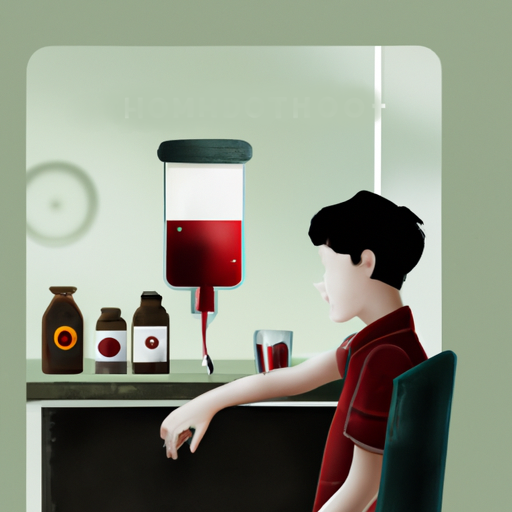
Introduction to Hemochromatosis
Hemochromatosis is a condition in which the body absorbs too much iron from food and it builds up in organs like the liver, heart, and pancreas. The iron buildup can cause damage and lead to conditions like liver disease, heart disease, and diabetes.
There are two types of hemochromatosis: primary and secondary.
Primary hemochromatosis is an inherited disorder that affects about 1 in 200 people of northern European descent.
Secondary hemochromatosis can be caused by a number of factors, including alcoholism, anemia, and certain infections.
Hemochromatosis can cause a range of symptoms, including fatigue, weakness, weight loss, and loss of sex drive. It can also cause liver disease, heart disease, and diabetes.
There is no cure for hemochromatosis, but it can be treated with phlebotomy, a process in which blood is removed from the body to reduce iron stores. Medications can also be used to reduce iron in the body.

If you have hemochromatosis, it's important to work closely with your healthcare provider to manage the condition and prevent complications. With proper treatment, people with hemochromatosis can lead normal, healthy lives.
Here are some key points to remember about hemochromatosis:
- Hemochromatosis is a condition in which the body absorbs too much iron from food.
- There are two types of hemochromatosis: primary and secondary.
- Hemochromatosis can cause a range of symptoms, including fatigue, weakness, weight loss, and loss of sex drive.
- Hemochromatosis can also cause liver disease, heart disease, and diabetes.
- There is no cure for hemochromatosis, but it can be treated with phlebotomy and medications.
- With proper treatment, people with hemochromatosis can lead normal, healthy lives.
If you think you may have hemochromatosis, it's important to see your healthcare provider for a proper diagnosis. They may recommend a physical exam, medical history, and blood tests to determine if you have the condition. With proper treatment, you can manage it and live a healthy life.
Definition of Hemochromatosis
Hemochromatosis is an inherited disorder caused by an excess absorption of iron in the body. This can cause excessive amounts of iron to build up in body tissues and organs, leading to organ damage. It is the most common form of iron overload disorder. Hemochromatosis is classified as either genetic primary hemochromatosis, which means that it is passed from parent to child, or secondary hemochromatosis, which means that it is caused by another condition or treatment.
Signs and Symptoms of Hemochromatosis
The signs and symptoms of hemochromatosis may vary from person to person, and some people may not experience any symptoms at all. Common signs and symptoms may include skin discoloration, fatigue, joint pain, weight loss, abdominal pain, and decreased sex drive.

Causes of Hemochromatosis
Hemochromatosis is primarily caused by mutations in the HFE gene. This gene helps regulate iron absorption in the body, so if it is mutated, it can lead to the excessive absorption of iron. Those with a family history of the condition may be more likely to develop it. In rare cases, it can also be caused by other diseases, such as cancer, or long-term alcohol abuse.
Risk Factors for Hemochromatosis
The primary risk factor for hemochromatosis is having a family history of the condition. Additionally, people of Northern European descent are more likely to develop the condition than other ethnic groups. Other risk factors may include age, sex, and certain medications.
Diagnosis of Hemochromatosis
To diagnose hemochromatosis, a doctor may order blood tests to measure iron levels, as well as other tests such as imaging tests or genetic testing. In some cases, a liver biopsy may also be performed.
Treatment of Hemochromatosis
The primary treatment for hemochromatosis is chelation therapy, which involves having blood removed from the body to reduce iron levels. Other treatments may include dietary modifications, exercise, and medication.
Complications of Hemochromatosis
If left untreated, hemochromatosis can cause a variety of serious health complications, including liver failure, heart disease, diabetes, and even death. It is important to seek medical advice as soon as possible to ensure proper diagnosis and treatment.

Long-Term Outlook for Hemochromatosis
The long-term outlook for those with hemochromatosis depends on the individual’s overall health, the severity of their condition, and their adherence to treatment. With early diagnosis and treatment, individuals may be able to live a relatively normal life with minimal complications.
Tips for Living with Hemochromatosis
Those living with hemochromatosis may benefit from the following tips:
- Stick to an iron-reduced diet.
- Exercise regularly.
- Stay hydrated.
- Get regular medical checkups.
- Be open with your doctor about your symptoms and treatment plan.
Dietary Recommendations for Hemochromatosis
Individuals with hemochromatosis should aim to include low-iron foods in their diet. These may include:
- Fruits and vegetables
- Whole grains
- Legumes
- Non-seafood proteins (such as tofu)
It is also important to avoid high-iron foods and beverages, such as organ meats, red meat, shellfish, and alcohol.
Lifestyle Changes for Hemochromatosis
In addition to dietary changes, individuals with hemochromatosis may benefit from making lifestyle changes to improve their overall health. These may include:
- Quitting smoking
- Limiting alcohol consumption
- Engaging in regular physical activity
- Getting sufficient sleep
- Managing stress
Preventative Measures for Hemochromatosis
There are no known preventative measures for hemochromatosis, but it is possible to reduce the risk of developing the condition. For example, avoiding alcohol and being aware of any family history of the condition can help reduce the risk.
Treatment of Iron Overload from Hemochromatosis
Iron overload caused by hemochromatosis can be treated through phlebotomy, which involves removing blood from the body to reduce iron levels. Other treatments may include medications, dietary changes, and lifestyle modifications.
Role of Genetic Testing in Hemochromatosis
Genetic testing can be used to diagnose hemochromatosis, as well as identify individuals who are at risk of developing the condition. Genetic counseling may be recommended to those with a family history of the disorder.
Managing Symptoms of Iron Overload from Hemochromatosis
The symptoms of iron overload can be managed by removing excess iron from the body through phlebotomy. Additionally, avoiding alcohol, eating a balanced diet, and exercising regularly can help reduce iron levels.
Treatment of Non-Iron Overload Symptoms of Hemochromatosis
Non-iron overload symptoms of hemochromatosis can be treated through lifestyle changes, such as quitting smoking and limiting alcohol, regular exercise, and stress management. Additionally, medications may be prescribed to treat specific symptoms.
Managing Mental Health with Hemochromatosis
Living with a chronic condition can be difficult, and it is important to ensure that mental health is being addressed. Practicing mindfulness and relaxation techniques, seeking counseling or therapy, and joining a support group may be beneficial.
Reaching Out for Support with Hemochromatosis
For individuals living with hemochromatosis, it can be beneficial to reach out for support. It may be helpful to join an online support group, connect with other people who have hemochromatosis, or reach out to friends and family for emotional support.
Conclusion: A Guide to Understanding Hemochromatosis
Hemochromatosis is a hereditary condition that can cause a variety of health complications and symptoms. With proper diagnosis and treatment, however, individuals can manage the symptoms of hemochromatosis and live a normal life. This guide provides a comprehensive overview of hemochromatosis, including its signs and symptoms, causes, risk factors, diagnosis, treatment, and long-term outlook. It also includes tips on lifestyle and diet modifications, as well as preventative measures to reduce the risk of developing the condition.



